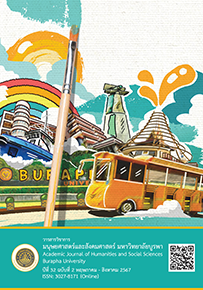An Analysis of Cultural Content Presentation Methods and Characteristics of Thai Textbooks in the People’s Republic of China
Main Article Content
Abstract
This is a documentary research. This research aimed to analyze the presentation methods and characteristics of cultural content from 4 sets (17 books) of Thai textbooks in different periods in the PRC. The results show that: 1) there are six main presentation methods of cultural content, including presentation in the text, exercises, post-reading, pictures, notes, and Tips. 2) The characteristics of cultural content presentation in Thai textbooks of different times are different. In the early Thai textbooks, Thai cultural content is mainly presented implicitly through texts. However, in Thai textbooks in the 21st century, Thai cultural content has been turned into explicit presentation. It is worth noting that presenting Chinese cultural content in Thai textbooks is an explicit method each time. In addition, primary Thai textbooks mainly use explicit methods in each set of textbooks, while middle and senior Thai textbooks mainly use implicit methods for cultural presentation.
Downloads
Article Details

This work is licensed under a Creative Commons Attribution-NonCommercial-NoDerivatives 4.0 International License.
บทความทุกบทความเป็นลิขสิทธิ์ของวารสารวิชาการมนุษยศาสตร์และสังคมศาสตร์ มหาวิทยาลัยบูรพาเท่านั้น
References
ตรึงตา แหลมสมุทร. (2556). การสร้างหนังสือเรียนภาษาไทยเบื้องต้นสำหรับนักศึกษาต่างชาติ. มหาวิทยาลัยเทคโนโลยีราชมงคลรัตนโกสินทร์.
นิธิ เอียวศรีวงศ์. (2538). ชาติไทย เมืองไทย แบบเรียนและอนุสาวรีย์ว่าด้วยวัฒนธรรม, รัฐและรูปการจิตสำนึก. มติชน.
วันเพ็ญ สกุลทอง. (2552). การสร้างแบบเรียนเรื่องพยัญชนะไทยสำหรับชาวต่างชาติ. [สารนิพนธ์ศิลปศาสตรมหาบัณฑิต, มหาวิทยาลัยศรีนครินทรวิโรฒ].
สุนีย์ ลีลาพรพินิจ. (2561). การวิเคราะห์เปรียบเทียบด้านรูปแบบและเนื้อหาที่ปรากฏในแบบเรียนภาษาไทยสำหรับผู้เรียนชาวจีน. วรรณวิทัศน์, 18, 185-210.
สุรีย์รัตน์ บำรุงสุข. (2551). ข้อสังเกตหนังสือเรียนภาษาไทยสำหรับชาวต่างประเทศที่ผู้เขียนเป็นชาวต่างชาติ.วารสารภาษาและวัฒนธรรมไทย, 2(3), 61-78.
ศรัญญา วาหะรักษ์. (2558). การนำเสนอวัฒนธรรมในหนังสือเรียนภาษาอังกฤษชั้นเรียนมัธยมศึกษาตอนปลาย และการรับรู้ของครู. [วิทยานิพนธ์ศิลปศาสตรมหาบัณฑิต, มหาวิทยาลัยสงขลานครินทร์].
อัมพร พงษ์ธา. (2518). การวิเคราะห์แบบเรียนภาษาไทยสำหรับผู้เริ่มเรียนชาวต่างประเทศ. [วิทยานิพนธ์ครุศาสตรมหาบัณฑิต, จุฬาลงกรณ์มหาวิทยาลัย].
Chen, X. (2012). แบบเรียนการสอนวัฒนธรรมไทย 4 ภาคสำหรับนักศึกษาจีน. [สารนิพนธ์ศิลปศาสตรมหาบัณฑิต, มหาวิทยาลัยศรีนครินทรวิโรฒ].
Gu, L. (2022). 大学英语教材中的文化呈现研究——以《新视野大学英语读写教程》为例 [A study on cultural presentation in college English textbooks: New horizon English course (reading and writing)]. English Square, (23), 114-117.
Li, J. และพัชรินทร์ บูรณะกร. (2022). ประวัติ พัฒนาการของแบบเรียนภาษาไทยในสาธารณรัฐประชาชนจีน. ใน Jonathan Rante Carreon (บรรณาธิการ), การประชุมวิชาการระดับชาติและนานาชาติ ครั้งที่ 9 (หน้า 703-716). มหาวิทยาลัยหัวเฉียวเฉลิมพระเกียรติ.
Liao, Y. (2008). 基础泰语1 [ภาษาไทยพื้นฐาน 1]. Guangdong World Book.
Lin, X., & Huang, J. (2012). 基础泰语4 [ภาษาไทยพื้นฐาน 4]. Guangdong World Book.
Liu, P., & Xue, Y. (2022). 推行国家统编教材的法理和依据 [Jurisprudential basis for implementing national unified textbooks]. Shanxi Education, (10), 31-33.
Ma, Y. (2016). 高校泰语本科教材现状,问题及对策 [Present situation and problems of Thai teaching material in universities of China and solutions]. Education and Teaching Research, 30(8), 95-101.
Su, Y., & Dong, X. (2021). 我国高校非通用语种专业教材建设的问题与对策 [Problems and countermeasures in the construction of less commonly taught foreign language textbooks in Chinese colleges and universities]. Foreign Language Education in China, 4(4), 77-83.
Zhang, H., & Li, X. (2022). 高中英语教材文化呈现研究 [Cultural representation in senior high school English textbooks]. Foreign Language Education in China, (4), 42-52.
Zhang, H., & Yu, R. (2020). 大学英语教材中华文化呈现研究 [Representation of Chinese culture in China’s college English textbooks]. Foreign Language Education in China, 3(3), 42-48.
Zhou, X., Zhang, Z., Sun, R., & Wu, Z. (2018). 国际汉语教材四十年发展概述 [A summary of the development of international Chinese textbooks in the past 40 years]. International Chinese Language Education, (4), 76-91.


